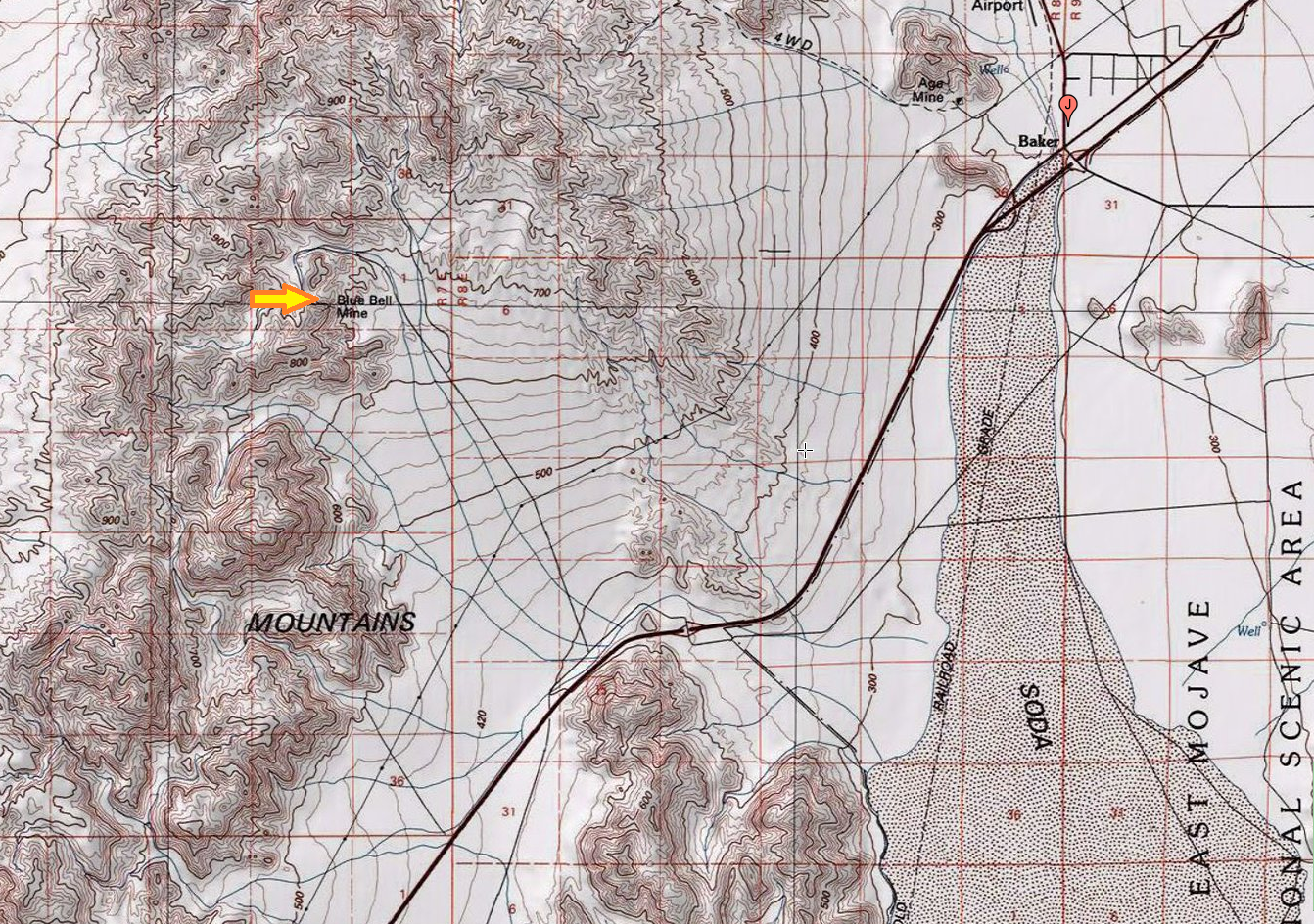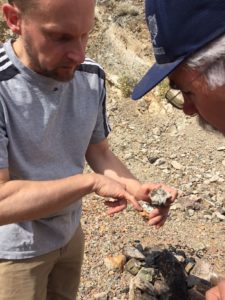Another beautiful Saturday morning, May 19, 2018. The meeting place was set at Zzyzx Rd exit off Interstate 15, just before the freeway heads down towards Baker located between Soda Lake and Silver Lake. I spent the previous night in Barstow, it’s only 60 miles east. Otherwise, it’s a long 160 miles trip all the way from Pasadena. The group met at 9AM at the meeting place and promptly headed north towards the beautiful Soda Mountains several miles away.

The road gets shaky and rocky around half way, with road conditions comparable to the Camp Rock Rd near Ord Mtn. SUVs with high clearance have no problem negotiating it, but there was a Chrysler rental van making it almost all the way up at the Pacific Micromount Conference fieldtrip a few years ago. The road is passable enough for determined rockhounds for now, but who knows for how long if it keeps deteriorating. On the way we stopped at the adit B turnoff to look at the mine hill and point out the main locations.

We kept going north on the dirt road around the mountain, up the hill, and then we’ve arrived at the adit A1 entrance area. It is a great parking spot for the cars that can make the last rocky part.

The Blue Bell mine (also known as Blue Bell claims and Hard Luck mine) has been mined since 1885 mainly for lead and silver, with minor copper, zinc and gold. In the 1950s first mineral specimens of linarite, caledonite and leadhillite started showing up, but the site gained the wide recognition with John Crowley’s article in Mineralogical Record in 1977. The mineral occurrences were further investigated by the San Bernardino County Museum volunteers led by Robert Reynolds. The intensive research led to publication of 5 previously unknown minerals by MSSC members: Anthony Kampf, George Rossman, and Robert Housley: plumbophyllite in 1997, reynoldsite and fluorphosphohedyphane in 2011, bluebellite and mojaveite in 2013. The total of 87 minerals has been found at Blue Bell mine so far, including such micromineral rarities as plumbotsumite, murdochite, tsumebite, kuksite, dugganite, quetzalcoatlite and pingguite.
See more info on Mindat: https://www.mindat.org/loc-144880.html). On Mindat you might also see some confusion about the naming of the sites unfortunately. Some contributors use location names as 2A, 2C and 2D, however, there is no need to use the initial number 2, which simply means Blue Bell mine in San Bernardino Co Museum publications. Mohawk mine is referenced number 1 there. So, here we will simply refer to Blue Bell locations as A thru F.
Our first mineral stop was the adit A1. I’ve shared some tsumebite specimens found there in December 2017 with the participants. The entrance has been cleaned up by some earlier visitors and it was easier to climb thru the hole. It was still a belly slide, but with more room above our buttocks than a few years ago. Inside the adit there is some light coming from the hole is the ceiling, so it’s not totally dark.

There are blue copper secondary veins higher up the walls, with beautiful baby blue chrysocolla. There is also some yellow pyromorphite and white sparkly cerussite. Nice pieces can be collected from the rubble on the bottom of the adit, no need to hammer the veins. The samples collected there also contained small bluish green dioptase crystals, dark yellow sparkly mimetite, clear hemimorphite and lustrous olive vauquelinite crystals. After looking at one of my specimens under the microscope I’ve also found a few small green tsumebite crystals.

From A1 we’ve climbed up to the A2 site, also called “glory hole”. This site was responsible for many great mineral specimens that called the attention of the mineral community to the Blue Bell mine. We’ve found several rocks with dark blue linarite needles on the way up thru the dump, then many more inside the opening. Some of the linarite was associated with green and blue chrysocolla, some with dark green brochantite, and the best ones with beautiful light blue crystals of caledonite. The rock on the back wall provided some small but great lustrous crystals of orange mimetite, yellow wulfenite and brown desclozeite.

When leaving for adit C we noticed the quickly raising air temperature, so Cheryl stayed behind and collected very picturesque manganese oxide dendrites instead. At the adit C site we’ve found a small orange vein on white opal covering highly siliceous grey-brown rock. The small orange and red specks turned out to be mimetite needles associated with yellow plates of wulfenite. A couple of specimens contained clear blocky fluorite and small hexagonal clear plumbotsumite crystals.

We then tried to keep going to sites over the big dike, which looks like a spine of the dragon and is very steep. However, the sun was relentless and the temperature already reached well over 90°F, so we collectively decided to head back and stay away from the heat.

That was a wrap, everybody left with a lot of colorful material in their buckets. On the way back we saw a large group of 4×4 enthusiasts chilling with beer in the canyon below the mine.

As a post-trip I’ve visited the adit B area taking a short but very bumpy detour off the main road. I’ve negotiated the entrance fees with the inhabitants of the adit, a rat and a bat, and continued inside. That adit is long and branching, not everybody would enjoy the visit. There was one area with ceiling covered almost completely with a blue mineral, which proved to be chalcanthite, mixed with gypsum and chalcopyrite. Some of the dark, almost black matrix specimens from the adit contained three interesting minerals. First, the dark green crystals were confirmed as atacamite, suggesting salt water interaction with copper ore in the mine, frequently post-mining. The atacamite was associated with lustrous dark blue balls of boleite, a very rare Cu-Ag-Pb halide mineral best known from Mexico as small dark blue cubes. Lastly, very dark violet-black bunches of platelets were identified as covellite. The atacamite and the covellite occurrence is reported from Blue Bell mine here for the first time.

Pictures in the report were taken by MSSC members.